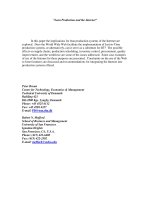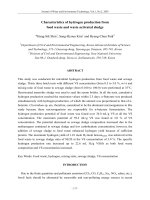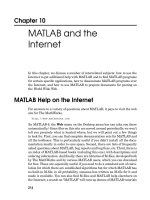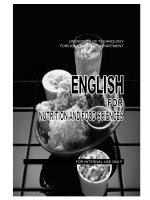Food, nutrition and culture internet
Bạn đang xem bản rút gọn của tài liệu. Xem và tải ngay bản đầy đủ của tài liệu tại đây (1.99 MB, 33 trang )
FOOD, NUTRITION & CULTURE
“Feeding oneself and one’s offspring is the
first concern of all living creatures”
- Frances Moore Lappe & Anna Lappe
WHY IS THE ACQUISITION OF FOOD
SO IMPORTANT?
• Question answered by the old adage “We are what
we eat.”
• All living creatures need to “take in nutrients to live.”
• Nutrition – the science that deals with the body’s
ability to transform nutrients found in “FOOD” into
“FUEL & FLESH.”
es
i
r
lo
a
C
Muscle
&
Tissue
PERSPECTIVES ON NUTRITION
• To scientists, nutrition is the
study of:
– The nutrients found in foods
– The body’s handling of
nutrients to maintain health
• Nutrients (some of which
provide energy for processes
in the body) are substances
that can promote:
– Growth
– Maintenance
– Repair
For many,
nutrition is all
about losing
weight!
WHAT IS FOOD?
•
•
Food is a conduit for nutrients.
It is one central thing about human experience that
can open up both our senses
and our experiences to our place in the world.
– Alice Waters
MEXICAN FOODS
ND T
A
EE FRUI
K
AC EAD
BR
OCTOPUS
PEARBUSH BUDS
Food is culturally defined, what is considered a food in
Culture A is not necessarily a food in Culture B.
THE NUTRIENTS
• Whereas there are many different foods.
There are only six classes of nutrients
namely:
– carbohydrates (CHO)
– proteins
– fats
– vitamins
– minerals
– water
• Usually, more than one class of
nutrients is represented in a food (e.g.,
(CHO, fats, proteins, water,
minerals [e.g., Ca] and vitamins
[e.g., Vitamin D] are in milk.
protein
TYPES OF NUTRIENTS
–Organic
(with C- C or C- H bonds)
Vi
ta
•CHO,
•Proteins
•Fats
•Vitamins
–Inorganic
•Water
•Minerals.
Fatty acids
Sodium and Chlorine ions
water
m
in
c
ENERGY YIELDING NUTRIENTS
• Carbohydrates
– glucose, (preferred
energy source)
fructose and galactose
• Fats
– fatty acids and glycerol
• Proteins
– amino acids
MORE FOOD RELATED
FACTS ….
• Vitamins - only organic nutrient that
does not supply energy but is needed to
get energy from foods.
• Essential nutrient - body cannot make
enough of and must get from food.
• Some dietary and lifestyle practices
(smoking, inactivity, drinking alcohol) are
risk factors for many health conditions.
• Substances (non-nutrients) in foods are
phytochemicals that give foods the
characteristic taste and smell.
FOOD CHOICES
• Select foods to provide adequate amounts of nutrients
and energy!
• When humans eat, foremost in their minds is that
they are consuming foods, not nutrients!
piz
za
• The following influence food choices:
• Personal Preference
• Advertising
• Positive Associations
• Availability
• Geographical location
• Convenience
• Social Pressure
• Economy
• Values and beliefs
• Comfort
• Body weight
• Ethnicity
• Habit
• Nutritional Value
CHALLENGE OF CHANGING FOOD
HABITS
• Food is about more than feeding the body. It is
embedded in family life, culture and religious ritual.
• Food has always been the most direct, intimate tie to
a nurturing earth and a primary means of bonding
with each other.
• Food has helped us to know where and who we are.
RELEASING NUTRIENTS FROM FOOD
• Digestion – process of breaking food into small substances
to be absorbed by the body and subsequently used for fuel,
growth, maintenance and repair.
Simple (e.g., phagocytosisengulf and form food
vacuoles in which food is
broken down in the
unicellular amoeba).
Complex (e.g., cooking and
chewing food before introducing
it to the sophisticated multiorgan, digestive system in
multi-cellular humans).
PRODUCTS OF DIGESTION
(Energy Nutrients) GLUCOSE
FRUCTOSE
GALACTOSE
CHO
FATS
PROTEINS
Gastrointestinal
System
FATTY
ACIDS
GLYCEROL
AMINO
ACIDS
MEASURING FOOD ENERGY
1g
1g
=
t
fa
9
lo
a
c
s
e
i
r
1g
pr
• Food energy measured
in calories.
ot
ei
n
=
4
ca
lo
r ie
s
s
e
i
)
r
t
o
n
CH
l
a
ie
•
A
calorie
is
not
a
c
r
O
t
7 nu
=
=
a
4 component of food. ol
t
ca
h no
o
c
lo
l
is
a
rie
l
s
1 g coho
l
a
(
ENERGY
•
Plants use the sun’s energy
to combine carbondioxide
and water to form glucose
and oxygen.
• Plants store energy as
starch.
• Humans eat plants and
other animals that have
also eaten plants.
6H2O + 6CO2
= C6H12O6 + 6O2
The Energy Cycle
The Cycle of life
begins with the
sun!
THE ABC….. OF A
NUTRITIOUS DIET
•
•
•
•
•
•
Adequacy
Balance
Calorie control
Moderation
Nutrient Density
Variety
DIETARY
GUIDELINES FOR
AMERICANS
!
d
e
at ed!
i
r
b
e
lat
n
i
u
m
m
I a o be e
tt
o
N
NUTRITION AND HEALTH
• Health professionals agree that the overall composition
of the diet has an important effect on health.
• Eating too much fat, sat. fat and cholesterol and not
eating enough vegetables, fruits, and fiber has been
linked to an increase in heart disease and other cancers.
• The federal government constantly revises its official
U.S. Dietary Guidelines for Americans to help consumers
choose a healthy diet.
• These guidelines make Recommendations for Americans
2 years of age and older.
NUTRITION GOALS FOR THE USA
Disease Related
• Reduce coronary heart disease;
• Reduce cancer deaths;
• Decrease incidence of diabetes;
• Reduce prevalence of
osteoporosis; and
• Reduce dental caries.
HOW MUCH FOOD DO WE NEED?
RDA (recommended dietary allowances)
• Primary nutrient intake standards for US for
many years.
DRI (dietary reference intake)
• Recently replaced RDA as primary standards
• Expands on RDAs
DRI GROUPS
• Recommendations made for various
age and gender groups as follows:
– Men
– Women
– Pregnant and lactating women
– Children
– teens
– elderly
MEAL PLANNING GUIDES
• Food group plan
• Exchange system
• Daily Food Guide
– (Food Pyramid)
EXCHANGE SYSTEM
•
•
•
•
Originally developed for diabetics
Lists of foods that can be exchanged
Food values are approximations
User makes an educated approximation
=
=
CHOOSING FOODS ………
•
Let the Pyramid guide your
food choices.
•
Choose a variety of grains
daily, especially whole grains.
•
Choose a variety of fruits and
vegetables daily.
•
Keep food safe to eat!
FOOD LABELS
• Food labels provide the following
information:
– Common name of product.
– Name and address of manufacturer,
packer or distributor.
– Net contents (wt, measure or count).
– Nutrient content of product
– Serving size
– Servings per container
– Calories/calories from fat
– Nutrient amounts and percentages of
Daily Values
– Daily values and calories/gram
reminder
– Ingredients









